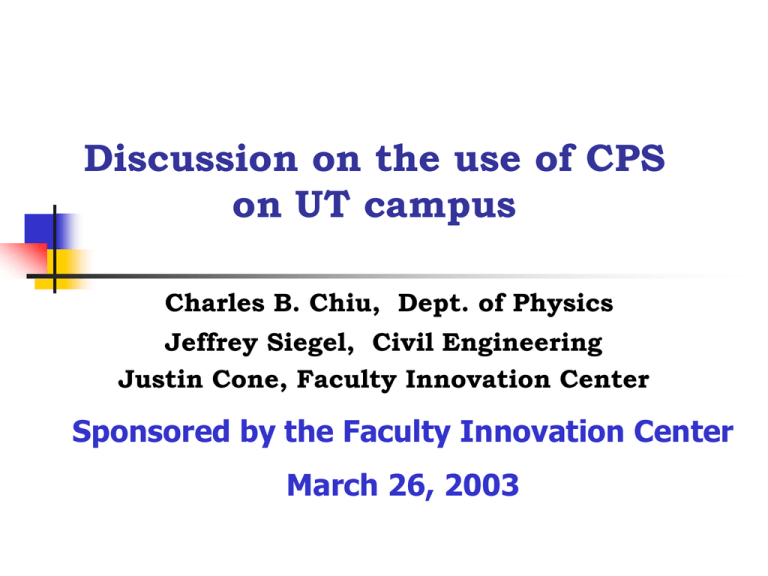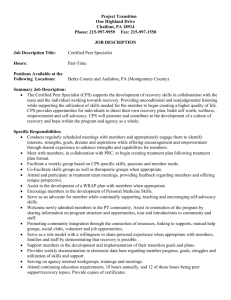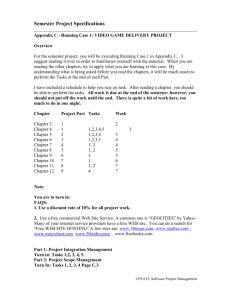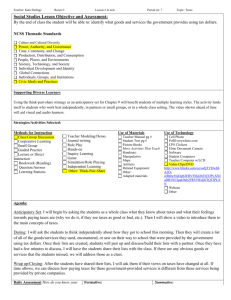CPS
advertisement

Discussion on the use of CPS on UT campus Charles B. Chiu, Dept. of Physics Jeffrey Siegel, Civil Engineering Justin Cone, Faculty Innovation Center Sponsored by the Faculty Innovation Center March 26, 2003 Outline A demo: Walking Dog. Qn:10.6.3 The system and record-posting Using Classtalk/CPS in CNS past and present Benefits in using the system Sample survey results How to get started using CPS? Outlook The system and record-posting Each student has a remote with response ID. The instructor posts a question. Students answer the question using own remotes. Response signals sent to a receiver and recorded by a computer. Bar chart of responses is displayed for feedback and discussion. Class session record is posted on the web, which is accessible to students and instructors. Will visit a sample record site later. Using Classtalk/CPS in College of Nat. Science For us, CPS is a successor of the Classtalk system – (a wired system, which was used in Physics Dept. from Fall 1996 to Spring 2001) First used of cps in Spring 2002: Bio 301M Summer 2002: Physics 303L, Bio 331. Fall 2002: ~18 classes used the system. Spring 2003: ~16 classes. See sec. I.2 of UT-CPS Support Homepage. Benefits in using the system Breaks monotony of straight lecture. Helps to emphasize important points. Anonymous responses encourage full classparticipation. Provide feedback to the instructor/students. Class record encourages class participation and attendance Next, sample survey results S1: Do you feel that discussing Classtalk questions during lecture help you to test your understanding of the material? 1. Yes, definitely. 29% 2. Helped frequently. 32% 3. Helped occasionally. 30% 4. Not at all. 9% 1. 2. 3. 4. Strongly increased 41% Increased 28% Slightly increased 19% No change 12% Percent S2: Does the use of the system change likelihood that students attend class? 40.0 35.0 30.0 25.0 20.0 15.0 10.0 5.0 0.0 38.0 26.5 Series1 Series2 17.6 11.1 Series3 Series4 1 Response S3: Overall, would you rate the system as a positive or a negative addition to this class? 1. 2. 3. 4. Very positive 32% Somewhat positive 42% Indifferent 17% Negative 9% Support for Instructors in using the system Presently 7 College of Natural Science Multimedia Classrooms are equipped with the system. Instructors, who will be teaching in one of these rooms and interested in using the system, can signup online (see sec I.1) There will be a cps-orientation session for instructors/TAs at the beginning of the semester. During the semester the ongoing class-session record can be viewed on the web. (See sec II. 1). What students needs know? There is one page cps-instruction for students. A Class ID assigned to the class is on the page. Each student buys a remote which has a unique Remote ID. Student enrolls online: Input above two IDs, to get his/her response ID for the class. Bring remote to class. Keep up with lecture material. Actively participate Q/A sessions. Tech. support: UT-CPS support, ITS help desk, CIT, Toll-free support by eInstruction. Outlook We started using Classtalk in 1996, to promote interaction in our Engineering Physics class & developed a program posting class-session record on the web. Our original effort in setting up the use of Classtalk/CPS (let us refer them as “classroom communication system”, CCS), has now evolved into a centralized support system. Our goal is to help interested instructors to quickly incorporate the use of CCS into their teaching repertoire. We hope this effort will lead to a wider use of CCS on our campus. This will in turn contribute to a definite impact on undergraduate education. Why I use CPS Promotes student interest Increases student interaction Provides feedback Reduces administrative chores How I use CPS Measure student attendance Survey class opinion Conduct periodic evaluations Focus review sessions Review material Evaluate curriculum What is my dog’s name? a) b) c) d) e) Sparky Rex Fido Spot Garfield What grade do you want in this class? A. B. C. D. E. F D C B A Why is DC sometimes used for power distribution? a) b) c) d) e) DC can have higher voltage AC has more losses DC requires fewer wires AC requires transformers DC companies have better lobbyists When calculating a cooling load, which outdoor temperature should you use? A. B. C. D. E. The peak temperature The average yearly temperature The average summer temperature The peak wet-bulb temperature None of the above Preliminary results Positive feedback from students Especially when it is employed to review material at the end of a lecture Strong correlation between performance on CPS review session and final grade Clear indication of curriculum strengths and weaknesses It is not a panacea Quizzes have academic honesty issues CPS software is very easy to use But, posting notes to course to software requires more effort CPS questions are not like exam questions CPS Price Models Justin Cone, Faculty Innovation Center Current Model - Standalone College Purchases: Complete CPS systems: • 2 Sets of 32 Response Pads • 2 Receivers • 2 Carrying Cases • Software $3995 per 2 systems (systems are sold in pairs) Student Purchases: $0 Standalone Pros & Cons Pros Student pays nothing Currently supported by FIC Cons System “juggling” Large initial expense to College Not scalable Scalable Model – CPS Online College Purchases: Student Purchases: • 1 Receiver per classroom • Software • 1 Response Pad ($7) • Enrollment Code ($12-15) per semester $250 per classroom $19-$22 per student (price of 1 receiver) After sellback: $16-$19 CPS Online Pros & Cons Pros Fully scalable Cost is shared between College and students Partnership with College of Natural Sciences “Homegrown” customizations Cons Cost effectiveness depends on usage




